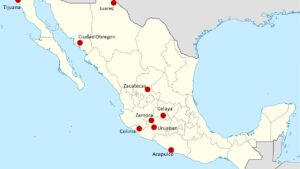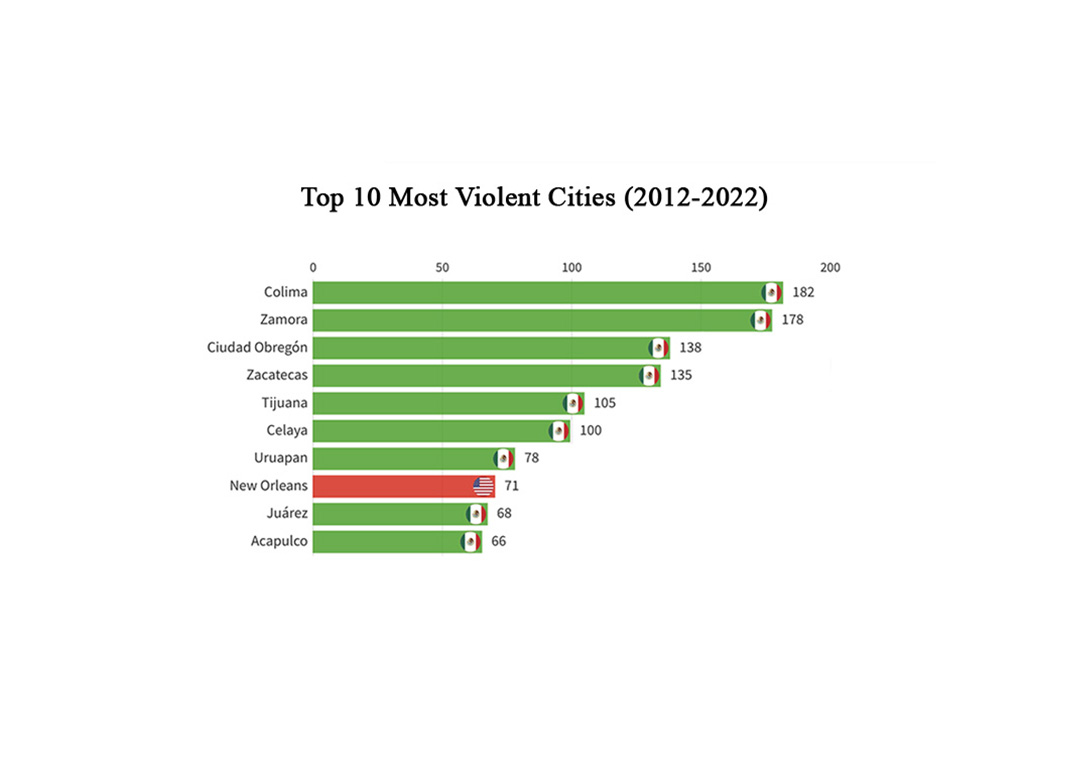Cities in Mexico dominate the list of the world’s most violent cities. According to data from Seguridad Justicia Paz, Mexico had nine of the top 10 most violent cities in 2022, and a Mexican city has led the list of the world’s most violent cities for the past six years. The ranking comes from a Seguridad Justicia y Paz report that rates the fifty cities with the highest homicide rates. The list has been published annually since 2010.
The Most Violent Cities in Mexico
 Mexico has had cities named among the top ten most violent in the world since 2010. As shown in the video at the top of the article, which presents data from 2012 to 2022, Mexican cities began to dominate the top 10 list in 2018.
Mexico has had cities named among the top ten most violent in the world since 2010. As shown in the video at the top of the article, which presents data from 2012 to 2022, Mexican cities began to dominate the top 10 list in 2018.
The nine Mexican cities on the list in 2022 are spread across the western part of Mexico. Tijuana and Juarez are located in the Northwest, along the border with the United States. Tijuana was the most violent city in both 2018 and 2019. Juarez topped the list in 2010 and has been consistently on the top 10 list for the last five years.
Colima and Zamora, the two cities ranked as the most violent in the world in 2022, are located west of Mexico City in the center of Mexico, along with Uruapan and Celaya. As cartel violence has increased in the region, this area has become increasingly violent in recent years. Acapulco, an iconic tourist resort in southern Mexico, has been on the list of the top ten most violent cities for 10 of the last 12 years and, on three occasions, has been in the top three.
Violence in Latin America
In 2022, 38 of the top 50 most violent cities were in Latin America, with three countries making up more than half of the list: Mexico (17 cities), Brazil (10), and Colombia (6). Drug trafficking, cartel violence, poverty, social inequality, and institutional weaknesses all contributed to high rates of violence.
While the rate of killings in Brazil and Honduras remains high, there has been a decrease in violence over the last decade. In Honduras, the homicide rate was 86 per 100,000 in 2012, much higher than the 59 per 100,000 figure in 2016.[1] San Pedro Sula, Honduras, was among the most violent cities from 2012 to 2014 but had a significant drop in 2016. In 2022, San Pedro Sula dropped to #44 on the list.
While it is important to note that San Pedro Sula’s city ranking and the factors contributing to its decline in subsequent years are complex and multifaceted, factors that may have contributed to the decline in its homicide rate might include the dismantling of large criminal organizations’ structures, police reform and training, prison system reform and modernization, economic improvement, job creation initiatives, and community-based violence prevention programs such as Cure Violence that aim to interrupt violence and reach at-risk individuals to provide them with resources, mentorship, and opportunities.
The Most Violent Cities in the US
The United States has continuously had cities on the top 50 list since 2010. In 2022, the United States had seven cities in the top 50, including one in the top ten, with New Orleans at number eight, the top US city ranking on the list. Other US cities on the list include Baltimore (17), Detroit (23), Memphis (25), Cleveland (27), Milwaukee (40), and Philadelphia (46). From 2010 to 2018, the United States had no cities in the top 10. In 2019, St. Louis made the top 10 list and remained on for three years. In 2022, St. Louis dropped out of the top 50 entirely, while New Orleans moved up the list.
Cure Violence Works in Many of the Most Violent Cities
 Cure Violence Global collaborates with local partner organizations in several of the world’s most dangerous cities. Cure Violence Global is now working with local partners, UNICEF, USAID, and others in Mexico to implement the Cure Violence strategy in Juarez and Culiacan, with plans to expand to Tijuana, Zamora, and Uruapan. Cure Violence Global also collaborates with local partners and UNICEF in six cities in Honduras: San Pedro Sula, Chamelecón, Choloma, Corozal, Sambo Creek, and Tegucigalpa. The Cure Violence strategy has been deployed in over 52 sites in Cali, Colombia, making it the world’s largest Cure Violence initiative.
Cure Violence Global collaborates with local partner organizations in several of the world’s most dangerous cities. Cure Violence Global is now working with local partners, UNICEF, USAID, and others in Mexico to implement the Cure Violence strategy in Juarez and Culiacan, with plans to expand to Tijuana, Zamora, and Uruapan. Cure Violence Global also collaborates with local partners and UNICEF in six cities in Honduras: San Pedro Sula, Chamelecón, Choloma, Corozal, Sambo Creek, and Tegucigalpa. The Cure Violence strategy has been deployed in over 52 sites in Cali, Colombia, making it the world’s largest Cure Violence initiative.
Since 2013, the Cure Violence approach has been implemented in Cape Town, South Africa. South Africa is the only country outside the Americas with cities among the top 50. In 2022, South Africa had four cities among the top 50, and Cape Town was among the top 10 cities in 2015, 2019, and 2020.
“Thanks to Cure Violence and the alliance with UNICEF, we are using violence interrupters to reduce homicide and femicide so that education, child protection, water and sanitation, all these wonderful interventions that help poor communities improve, they work.” Mark Connolly, UNICEF Representative in Honduras.
Your Role in Stopping the Spread of Violence
The rates of killing in many countries is an epidemic that urgently calls for the attention and collective action of civil society organizations, governments, and international agencies. Implementing more robust and collaborative measures is vital to addressing these alarming homicide rates and, ultimately, saving lives. It is a call to us all to actively participate in initiatives promoting peace and safety in our societies by raising awareness, advocating for effective policies, and supporting organizations like Cure Violence Global. We all have a role to play in saving lives and making our cities and communities — local and global – safer.
—————————————————–
[1] Violence Observatory at the National Autonomous University of Honduras (Universidad Nacional Autónoma de Honduras – UNAH).


